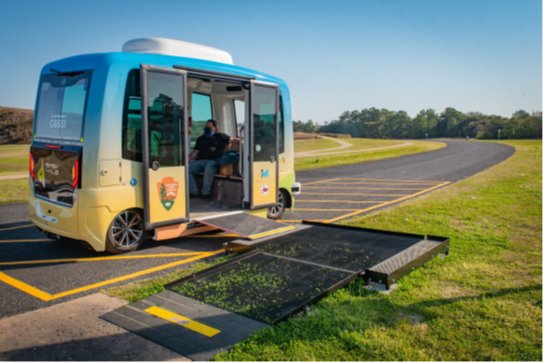National Park Service and NCDOT Conducted An Automated Shuttle Pilot on a 1.5 Mile Loop through the Wright Brothers National Memorial.
Kill Devil Hills, NC
First in Flight, First in Automation: NCDOT and NPS Pilot an Automated Shuttle at the Wright Brothers National Memorial
Summary Information
Emerging mobility technologies, such as automated shuttle technologies, have the potential to improve the quality of transit service for first-/last mile transportation. With the goal of improving visitor experience and resource protection as well as advancing alternative mobility solutions, an electric, automated shuttle pilot, the “Connected Autonomous Shuttle Supporting Innovation” (CASSI), was conducted at the Wright Brothers National Memorial by the National Park Service (NPS) and the North Carolina Department of Transportation (NCDOT). This pilot ran from April to July 2021 for a total of 64 days of operation (46 days with full operation) with a single shuttle equipped with various sensors (e.g., lidar, radar, and camera units) and an automated driving system (ADS) capable of operating at SAE automation Level 4 (High Driving Automation). The shuttle took riders on a roughly 1.5-mile loop through Wright Brothers National Memorial and was scheduled every 15 minutes, in which ridership was first-come, first-served. The operating hours were Monday through Friday between 10:00 a.m. and 4:30 p.m. Although the maximum capacity of the shuttle is 12 passengers, the pilot limited it to 6 passengers. Data collection involved weekly reports from the operator, monthly disengagement reports, monthly operational reports, and a survey after the riders rode the shuttle.

METHODOLOGY
Performance of the shuttle was assessed by a mixed-methods approach, using quantitative statistics, survey data, and qualitative interviews with relevant stakeholders. Various performance measures, including speed, battery usage, weather impacts, and disengagement were assessed. These performance measures measured how long the shuttle would stay in automated mode and the efficiency of its operation. Disengagement reports collected statistics on three types of stops: 1) An “e-stop”, which is a stop triggered either manually by the operator or automatically by the vehicle computers when an obstacle gets too close, 2) a “soft stop”, which is triggered either manually by the operator on the operator panel or automatically by the vehicle computers when an obstacle is identified ahead in the shuttle’s future path, and 3) a “circumvention”, which occurs when the operator switches from automated mode to manual mode. A user experience survey was distributed by the operator of the automated shuttle to individuals who rode the shuttle. In total, 273 responses were collected with at least one survey question answered.
FINDINGS
- The shuttle served 3,380 riders with a total of 809 trips. According to the disengagement reports, the shuttle was estimated to be driving in automated mode around 87 percent of the time on average. There was a daily average of 1.3 e-stops, 7.4 soft stops, and 2.0 circumventions for the days with full operations, which indicated that a safety operator is still required to be onboard the shuttle.
- Survey results showed an increase in the perception of safety after riding the automated shuttle. Seventy percent of the respondents felt “somewhat safe” or “very safe” prior to riding the shuttle, and 86 percent felt somewhat safe or very safe after riding the shuttle.
- Nearly 90 percent of shuttle riders felt that “the shuttle arrived at my stop within a reasonable amount of time”, with only 7.3 percent "strongly disagreeing" or "disagreeing" with this statement.
- Many respondents perceived the shuttle to be an attraction in-and-of itself (62 percent). A small percentage (7 percent) used the shuttle to get to their destination and 32 percent used it for both situations.
- Over 94 percent of respondents “Somewhat” or “Strongly Agreed” with the desire to see more driverless shuttles in National Parks.
